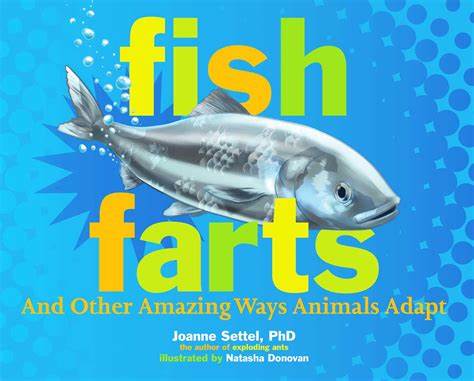Fish Farts and Other Amazing Ways Animals Adapt

Fish Farts and Other Amazing Ways Animals Adapt
The contents of Fish Farts and Other Amazing Ways Animals Adapt are divided into five major sections: : “Curious Communications”, “All-Purpose Poop”, “Escaping the Enemy”, “Super Strange Insides” and “Creepy Connections”, with each section containing from three to five two-page titled entries, 18 in total. For example, the marine flatulence referenced in the book’s title is explained in “Fish Farts”, one of the five subsections of “Curious Communications”. There, young readers will learn that the farts of hundreds of thousands of herrings that are swimming together in a shoal are actually what keep the herrings from bumping into each other. “Since herring have excellent hearing, each herring can tell from the fart pops just how close its neighbors are and maintain a steady distance from them.” Evidently, a herring can shoot out 40 farts in a second.
Each of the book’s 18 principal entries also provides supplementary information that is printed on a different coloured background. Varying from one to three numbered paragraphs, this information sometimes speaks directly to the pages’ main focus. Such is the case with “Sloth Poop and Moth Eggs – A Perfect Pair”, found in “All-Purpose Poop”. In the main text, Settel explains the relationship that exists between a moth that lives on the sloth’s fur and the sloth’s poop. The two additional paragraphs address how the sloth’s body has adapted to its upside down existence and the dangers related to its once a week tree descent for the sole purpose of defecating. In other cases, the additional information offers additional examples of the adaptation being highlighted in the main text. For example, “A Mouthful of Froglets”, part of “Escaping the Enemy”, describes how a male Darwin frog keeps its young safe by “stash[ing] fifteen or more wiggling eggs or newly hatched tadpoles in his vocal sacs, the stretchy throat pouches that frogs use to make croaking sounds.” Some 70 days later: “With a few coughs, the dad spews out a bunch of tiny – bitsy, tailless frogs.” In the first added info section, readers learn about a male hardheaded catfish that “carries up to forty-eight eggs in its mouth and goes without eating for two months while his young develop.” In the second numbered paragraph, Settel focuses on the females of two frog species whose safety-for-their- developing-young adaptation involves pouches on the females’ backs where the fertilized eggs remain until they become tadpoles or develop into frogs.
Each of the 18 entries is accompanied by one of Donovan’s full-page, digitally rendered illustrations that features the pages’ adaptation. For instance, Donovan’s illustration connected to “Ant Shampoo”, located in “Creepy Connections”, reveals a blue jay standing atop an ants nest while the ants climb up the bird’s breast and over its outspread wings. Settel’s adjacent text explains that many birds, including the blue jay, use the formic acid that the ants spray as a “shampoo” to deal with itchy spots caused by lice or mites. Donovan also contributed six spot illustrations to add visual clarity to a text point, such as the cutaway of the Darwin frog with the label “A peek at the tadpoles hidden inside the Darwin frog father’s vocal sack.”
End matter consists of a three page glossary containing the definitions of words that were highlighted in the main or secondary texts. For example:
Tadpoles: Young, newly hatched frogs and toads. They have tails and gills and breathe in the water. As they change or metamorphose into their adult forms, tadpoles grow legs and lungs, and lose their tails and gills.
Readers who enjoy Fish Farts and Other Amazing Ways Animals Adapt can be referred to Settel’s earlier book, Exploding Ants: Amazing Facts About How Animals Adapt
Dave Jenkinson, CM’s editor, lives in Winnipeg, Manitoba.
